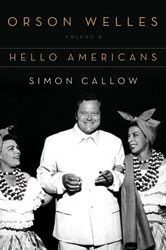(Viking, 444 pages, $32.95)
By Simon Callow
 Whatever happened to Orson Welles after Citizen Kane? That is the compelling question that Simon Callow, in this follow-up to the first volume of his highly acclaimed Welles biography, The Road to Xanadu, attempts to answer. Callow, a British actor, director and writer who has appeared in films such as Four Weddings and a Funeral and Shakespeare in Love, took ten years writing this book and the lengthy gestation pays off. Spanning the years 1941-1947, the book is a riveting portrait of a larger-than-life man during a time of monumental historical importance. Beginning at the height of Welles’ success following the glittering premiere of his controversial masterpiece, the story tracks his singularly strange career crash-and-burn over the next several years. A man with both a prodigious ego and a powerful social conscience, Welles is vividly brought to life in all of his contradictory splendor. Shortly after the Japanese attack on Pearl Harbor, Welles was enlisted by the U.S. government to make a documentary about the Carnival in Rio de Janeiro–a film designed to strengthen our relations with Latin America at a time when we were intent on building allies. The unfinished documentary, It’s All True, would prove to be a detour from Welles’ Hollywood career from which he would never recover.
Whatever happened to Orson Welles after Citizen Kane? That is the compelling question that Simon Callow, in this follow-up to the first volume of his highly acclaimed Welles biography, The Road to Xanadu, attempts to answer. Callow, a British actor, director and writer who has appeared in films such as Four Weddings and a Funeral and Shakespeare in Love, took ten years writing this book and the lengthy gestation pays off. Spanning the years 1941-1947, the book is a riveting portrait of a larger-than-life man during a time of monumental historical importance. Beginning at the height of Welles’ success following the glittering premiere of his controversial masterpiece, the story tracks his singularly strange career crash-and-burn over the next several years. A man with both a prodigious ego and a powerful social conscience, Welles is vividly brought to life in all of his contradictory splendor. Shortly after the Japanese attack on Pearl Harbor, Welles was enlisted by the U.S. government to make a documentary about the Carnival in Rio de Janeiro–a film designed to strengthen our relations with Latin America at a time when we were intent on building allies. The unfinished documentary, It’s All True, would prove to be a detour from Welles’ Hollywood career from which he would never recover.
Leaving the editing of the troubled The Magnificent Ambersons to Robert Wise, Welles ended up spending six months in South America, shooting a film about the real Rio that rocked the powers-that-be back home when it became clear he intended to show slum-dwellers as well as interracial couples doing the samba. Fueled by booze, amphetamines and chorus girls, Welles shot roll after roll of film, ultimately going from being celebrated to being vilified by the Brazilians when a local folk hero drowned during the shooting. This South American sojourn takes up nearly a third of the book and is relayed in stunning detail–perhaps excessive detail at times, but fascinating nonetheless. The remaining chapters chart Welles’ checkered career as an actor-for-hire, radio personality, magician, political speechmaker and substitute radio host for Jack Benny. Interspersed are film projects that never come to fruition (War and Peace) and those that do (Macbeth, The Lady from Shanghai), but which never reach the artistic high watermark of Citizen Kane. Throw into the mix a colorful personal life that included a tempestuous marriage to Rita Hayworth, a close relationship with Roosevelt’s vice-president, Henry Wallace, and lunches with Bertolt Brecht, and you have a portrait of a man as unique and unforgettable as Charles Foster Kane himself.
Review written by Gloria Norris.